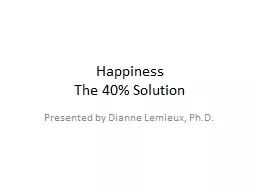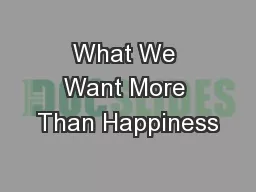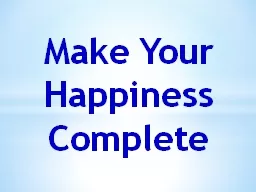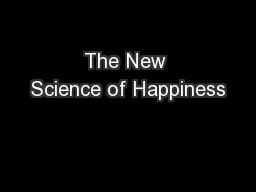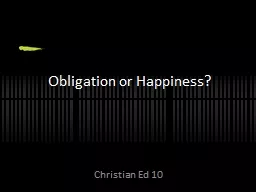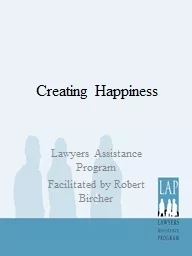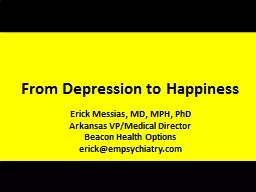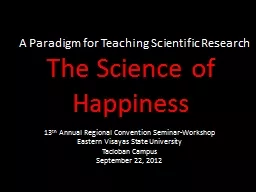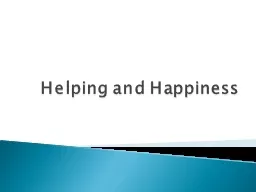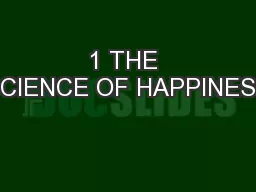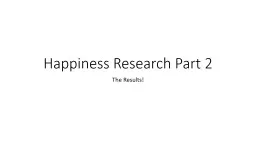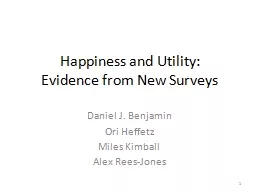PPT-Happiness The 40% Solution
Author : trish-goza | Published Date : 2020-01-02
Happiness The 40 Solution Presented by Dianne Lemieux PhD Happiness The 40 Solution Part One Science of HappinessA Brief Tour Historical roots philosophical religious
Presentation Embed Code
Download Presentation
Download Presentation The PPT/PDF document "Happiness The 40% Solution" is the property of its rightful owner. Permission is granted to download and print the materials on this website for personal, non-commercial use only, and to display it on your personal computer provided you do not modify the materials and that you retain all copyright notices contained in the materials. By downloading content from our website, you accept the terms of this agreement.
Happiness The 40% Solution: Transcript
Happiness The 40 Solution Presented by Dianne Lemieux PhD Happiness The 40 Solution Part One Science of HappinessA Brief Tour Historical roots philosophical religious and cultural Psychological. and . Well-Being . in an . Age . of . Austerity. : . T. he . E. xistential Dilemma. Social Science in the City™ . Dr Graham Taylor. Associate Professor in Sociology. Department of Health and Applied Social Sciences. A lecture on Subjective Well-Being and JDM. Ann Marie Roepke. JDM. 10.17.11. happiness. everyone wants “happiness” but everyone doesn’t agree on what “happiness” is.. two reasons to avoid the word “happiness”. Conversation 1: . Happiness . in the . Presence . of Conditional Happiness. Happiness in the . Absence . of Conditional Happiness. We have joy in adversity because we are protected by the power of God. Ed . Diener. June 19, 2013. Happiness and its Causes. Melbourne, Australia. Gratitude. . To Tony Steele, Beth Phelan and all the organizers. Subjective Well-Being (SWB. )?. “Happiness”. People’s . Christian Ed 10. What is morality?. Think. Pair. Share (within a group of four & come up with a standard definition) . Morality . A set of norms or rules that determine the sinfulness or goodness of an act. . Lawyers Assistance Program. Facilitated by Robert Bircher. What Makes us Happy?. If only I were rich, famous and beautiful-then I would be happy. When I get/achieve/complete ____ then I will be happy. Erick Messias, MD, MPH, PhD. Arkansas VP/Medical Director. Beacon Health Options. erick@empsychiatry.com. Plato. (427-347 BC). Studied under Socrates. Founded the Academy. Tutored Aristotle. Aristotle. 13. th. Annual Regional Convention Seminar-Workshop. Eastern . Visayas. State University. Tacloban. Campus. September 22, 2012. A Paradigm for Teaching Scientific Research. Rationale: Why I am researching happiness. Altruism vs. . Prosocial. behavior. Why do people help? . Or not help? . http://www.msnbc.msn.com/id/43880728/ns/world_news-europe/. https://. www.youtube.com/watch?v=N9KuUR2-p9Q. Do animals show prosocial behavior? . Catherine A. Sanderson. Amherst College. Overview. 2. Why Do We . Care . About Happiness. ?. What Do We . Think. . Makes Us Happy (But Really Doesn’t)?. What Actually . Does. Make Us Happy?. Conclusions … . Lesson 30. Recap Lesson 29. Learn Alma’s . counsel for remaining faithful in the . gospel.. Help . parents understand how to teach and counsel both righteous and unrighteous children.. Purpose. Gain . La gamme de thé MORPHEE vise toute générations recherchant le sommeil paisible tant désiré et non procuré par tout types de médicaments. Essentiellement composé de feuille de morphine, ce thé vous assurera d’un rétablissement digne d’un voyage sur . The Results!. Happiness and Wealth. The Traditional View. “I’ve been rich and I’ve been poor; believe me, rich is better”. --Mae West. Kahneman & Deaton (2010). 450,000 U.S. subjects in the Gallup-. Happiness and Utility: Evidence from New Surveys Daniel J. Benjamin Ori Heffetz Miles Kimball Alex Rees-Jones 1 Motivation Our question: How does revealed preference relate to measures of happiness?
Download Document
Here is the link to download the presentation.
"Happiness The 40% Solution"The content belongs to its owner. You may download and print it for personal use, without modification, and keep all copyright notices. By downloading, you agree to these terms.
Related Documents

